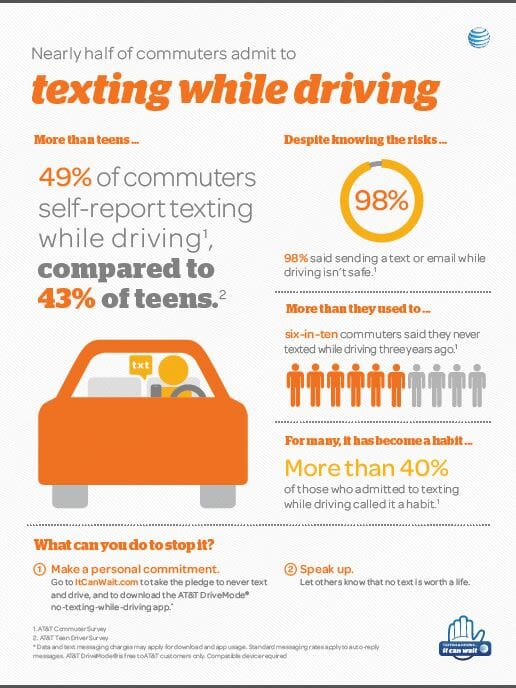

- #Texting while driving risk vs undistracted drivers
- #Texting while driving risk vs undistracted driver
#Texting while driving risk vs undistracted drivers
The scale demonstrated strong validity and reliability in drivers age 24 and younger. Drivers should not assume that they can handle texting while driving and remain safe. The DDS is an 11-item scale that measures cell phone-related distracted driving risk and includes reading/viewing and writing subscores. Text messaging was common 59.2 and 71.5 % of respondents said they wrote and read text messages, respectively, while driving in the last 30 days. The survey can be completed in two minutes, or less than five minutes if demographic and background information is included. For every 1 unit increase of the DDS score, the odds of reporting a car crash increases 7 %. The score is reported on a 0-44 scale with 44 being highest risk behaviors. In 228 drivers 18-24 years old, the DDS showed excellent internal consistency (Cronbach's alpha = 0.93) and correlations with reported 12-month crash rates. Texting while driving doesn’t seem much riskier than getting behind the wheel at all. 20 of drivers age 18-20 said texting does not influence their driving ability, and nearly 30 of drivers ages 21-34 said. For the undistracted part of the drive, the. Texting is typically the first thing that comes to mind when thinking of distracted driving and for a good reason. Despite 84 of drivers recognizing cell phone distractions while driving as unacceptable, 36 of the same drivers admit to reading email or sending a text message while driving in the previous month.

Nearly all of those we spoke with admitted to texting from behind the wheel often. smartphone distraction for all ages and for both voice and texting. There is no stigma to admitting to texting while driving.
#Texting while driving risk vs undistracted driver
The National Highway Traffic Safety Administration says that texting while driving is the most common cause of teenage driver deaths. It can be either vehicular collisions or hitting a pedestrian. According to the Virginia Tech Transportation Institute, you are six times more likely to be in a motor vehicle crash while driving if you’re texting, versus if you were intoxicated. One of the most obvious dangers of texting and driving is an increase in the risk of a traffic accident. Questions focused on texting while driving and use of email, social media, and maps on cellular phones with specific questions about the driving speeds at which these activities are performed. TEXTING WHILE DRIVING IS THE NEW NORMAL 9 In the spectrum of risky driving behaviors, texting barely registers. Texting While Driving Is More Dangerous Than Intoxication Texting while you are driving is more dangerous than if you are under the influence of alcohol. Survey questions were developed by a research team using semi-structured interviews, pilot-tested, and evaluated in young drivers for validity and reliability. This paper describes the development and preliminary evaluation of the Distracted Driving Survey (DDS) and score. Texting while driving and other cell-phone reading and writing activities are high-risk activities associated with motor vehicle collisions and mortality.


 0 kommentar(er)
0 kommentar(er)
